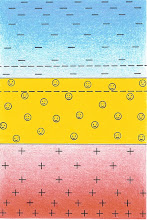- The pioneering discoveries of German zoologists Wolfgang Wiltschko and his wife Roswitha in the late 1960’s and 1970’s. They found that the seasonal migratory direction of caged European Robins can be changed to the opposite direction by reversing the inclination of the artificial magnetic field in the cage. They discovered that migratory birds have an “inclination compass”, in which birds can sense the inclination of the magnetic field lines and adjust their course based on whether they are moving toward the magnetic pole or equator.
- The theoretical work of Klaus Schulten and Thorsten Ritz on the radical-pair mechanism for magnetoreception. This theory argues that the inclination compass that the Wiltschkos discovered via behavioral experiments with birds is located in the retina of a bird’s eye. Radical-pair reactions in the photoreceptor protein cryptochrome can be affected by the direction of the geomagnetic field, providing a bird with a way to sense magnetic field inclination. In the past 10 to 15 years, researchers have obtained circumstantial evidence for this theory, including the disruptive effects of high-frequency (MHz) radio waves, the discovery of long-lived radical pairs in bird cryptochrome, the discovery of cryptochrome in all UV/violet cones in retinas of European robins and chickens, and genetic knock-out experiments involving Drosophila flies.
- American neurobiologist Ken Lohmann’s discovery of sea turtles’ inner GPS abilities. Animals can use the geomagnetic field inclination and intensity as magnetic “signposts” that provide positional information. In groundbreaking experiments, Lohmann and associates found that juvenile green turtles will swim south in a cage that has an artificial magnetic field with inclination and intensity representing a northern location (from their home), and swim north if the artificial magnetic inclination and intensity represent a southern location. Since inclination and intensity vary primarily in a north-south direction (from the magnetic equator to the pole), it’s reasonable that animals can use these parameters as a basis for a north-south map. What was surprising was an experiment with caged loggerhead turtles in which they were able to recognize the inclination and intensity magnetic signatures on the eastern and western ends of the North Atlantic ocean. The turtles adjusted their headings to that corresponding to remaining in the warm water gyre, something that they would need to do in nature to survive the long migration across the Atlantic ocean. This was first evidence that animals can encode longitudinal information as well as latitudinal by means of perception of magnetic parameters.
- Le-Qing Wu and David Dickman’s recent discovery of neurons in a pigeon’s vestibular nuclei that respond to information about a bird’s magnetic surroundings. The scientists at Baylor College of Medicine, using electrophysiological single-cell recordings, identified 53 different neurons whose firing patterns are affected by magnetic stimuli. Each neuron is finely tuned to a magnetic field coming from one particular direction, with magnetic field intensity roughly equivalent to that of the geomagnetic field.
- The search for the magnetite-based magnetoreceptor in animals. Impetus for this came from the discovery of magnetotactic bacteria in the 1970’s, which possess organelles called magnetosomes containing chains of magnetite crystals. Behavioral studies of birds have indicated that magnetic sensing may occur via the ophthalmic branch of the trigeminal nerve, which extends to the beak. This type of magnetic sensing is independent of the radical pair-based mechanism in the retina, and may be based on magnetite. Although researchers have tried for years, so far there hasn’t been conclusive proof of intracellular magnetite within neurons in animals. Wu & Dickman's electrophysiological studies of pigeons indicate that magnetite-based magnetoreceptors may be found in the inner ear.
- Excellent diagrams explaining the hypothetical magnetite-based and retinal-based magnetoreception processes.
- Scientific journal references to allow the reader to study magnetoreception further.
- In concluding remarks, the author states that “there are several hypotheses supported by strong, albeit not yet conclusive, data.” Momentum seems to be building, although compared to more mainstream bioscience research, resources put into the study of magnetoreception are miniscule. According to one of the magnetoreception researchers, German geophysicist Michael Winklhofer, “It’s really tough work, but it’s also exciting, because everybody wants to be the first to demonstrate how this extra sense works.”
Thursday, February 26, 2015
Good Introduction to the Science of Magnetoreception
I recently came across an article published in 2013 in The Scientist magazine that is the best short introduction to magnetoreception for non-experts that I've read. For those who are unfamiliar with the term, "magnetoreception" is animal perception of the geomagnetic field that is used for orientation and navigation. There are a number of review articles on magnetoreception published in scientific journals, but these can be hard to follow for people who aren't scientists working in this biological subfield. This article in The Scientist magazine provides a clear summary of the scientific facts, the historical context, and biographical sketches about scientists working in the field. Some highlights include:
Subscribe to:
Posts (Atom)
